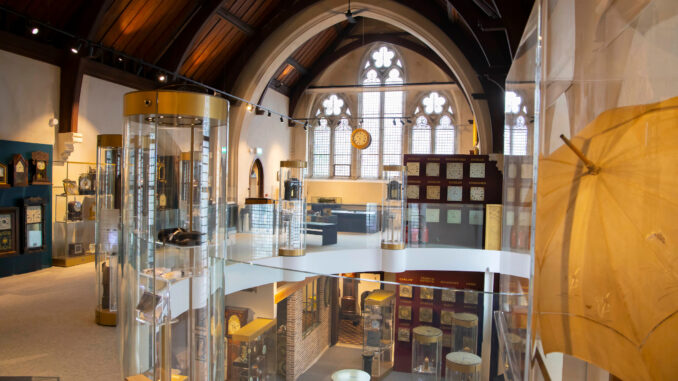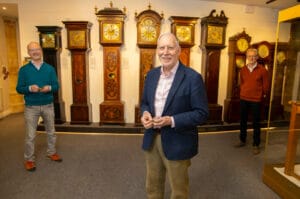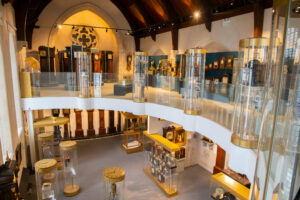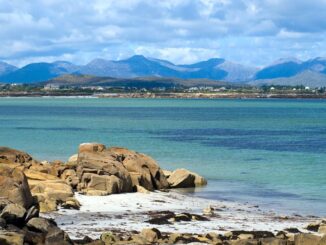
The Irish Museum of Time
Speaking of the launch of Ireland’s newest museum, Waterford Treasures Museum Director Eamonn McEneaney says, “This is the finest collection of Irish timepieces in the world. Waterford Treasures is proud to celebrate the incredible skills of the virtuoso craftsmen who, since the seventeenth century, created timepieces of remarkable beauty and technological genius.”
The collection is not limited to Ireland, also on display are early European timepieces, the earliest dating back to 1551, along with clocks and watches from Switzerland, England, Germany, France, Italy, Austria, the Netherlands, USA, Canada, Russia and as far away as Japan and Australia.
The Irish Museum of Time is located in the heart of the Viking Triangle in Waterford, Ireland’s oldest city. Housed in a former neo-Gothic style Methodist Church built in the 1880s, the museum lies beside the ruins of the medieval Franciscan Friary church.

The original Franciscan Friary dates to 1241, and was built by an Anglo-Norman knight, Sir Hugh Purcell. King Henry III, King of England and Lord of Ireland gave permission for the establishment of the friary and gave the friars an annual grant to purchase habits. Because of the grey habits originally worn by the Franciscans the friary was also known as Greyfriars.
For the next 300 years the Franciscan friars were firmly established here in Waterford working among the poor. They had renounced the world and embraced a life of prayer and poverty. In common with other religious orders, Franciscans prayed at regular intervals throughout the day. They rose with the bell early in the morning for Matins and their day ended when the bell tolled for Compline in the evening.
However in the turbulent years of the 16th century the lives of the Franciscan friars here changed utterly. From the late 1530s King Henry VIII dissolved all the monasteries across England and Ireland. The Waterford friary was dissolved in 1540 and one year later in 1541 the buildings were granted to Patrick Walsh, a local merchant. He obtained a charter from the king granting him permission to establish an almshouse here, the Holy Ghost Hospital, ‘in which sixty old and decrepit people, unable to earn a living, have beds.’

Like the Franciscans who had occupied the site for three centuries, the lives of the residents were dominated by the bell. One of the provisions of Henry VIII’s charter was that the residents had to rise from their beds each night to pray for the repose of the king’s soul, a tradition which continued well beyond his death. The Holy Ghost Hospital, which still exists today, is one of Ireland’s oldest institutions. In the 19th century the trustees decided to move from Greyfriars to its present location on the Cork Road.
One of the most influential Franciscans of the 17th century was Waterford’s very own Luke Wadding, and his statue stands outside the ruins of the medieval friary church. Even though Wadding was born in 1588, over forty years after the friary was dissolved, he had always wanted to be a Franciscan priest. When based in Rome in the 1630s it was he who was in charge of creating the official list of saints of the Roman Catholic Church. While he was compiling this list, he slipped in an extra saint, adding in Saint Patrick, someone unknown outside of Ireland and he also fixed St. Patrick’s Day as the 17th of March.
In 1689, the Dutch Prince William of Orange and his wife Mary became King and Queen of England, Ireland and Scotland. They encouraged Protestant refugees from France to settle in Ireland. These refugees were known as Huguenots. The Huguenots who settled in Waterford were given part of this old Franciscan friary as a place of worship and so it became known as the French Church, a name that has lasted to this day. Many of these Huguenots were skilled craftsmen and included watch and clockmakers as well as gifted cabinet makers, specializing in the intricate marquetry and wood carving which is to be found on many of the cases of the long case clocks on display in this museum.
Now beside this historic location in the heart of Waterford city, Ireland’s only horological museum is located. The museum features the oldest Irish-made long-case clocks, bracket clocks and watches in the world and celebrates the incredible skills of the virtuoso craftsmen who, since the seventeenth century, created timepieces of remarkable beauty and technological genius. The collection is not limited to Ireland, also on display are early European timepieces, some dating back to the mid-sixteenth century along with a display of clocks and watches from Switzerland, England, Germany, France, Italy, Austria, the Netherlands, Russia and as far away as Japan.
Set out over two floors visitors can enjoy a self-guided experience at the new Irish Museum of Time with interactive displays showcasing the story of the museum’s significant pieces. Tickets are available to pre-book at www.waterfordTreasures.com at €5 per person.
The museum was made possible thanks to the remarkable generosity of Mr David Boles, Mr Colman Curran and Ms Elizabeth Clooney whose lifelong collections were gifted to the museum.



